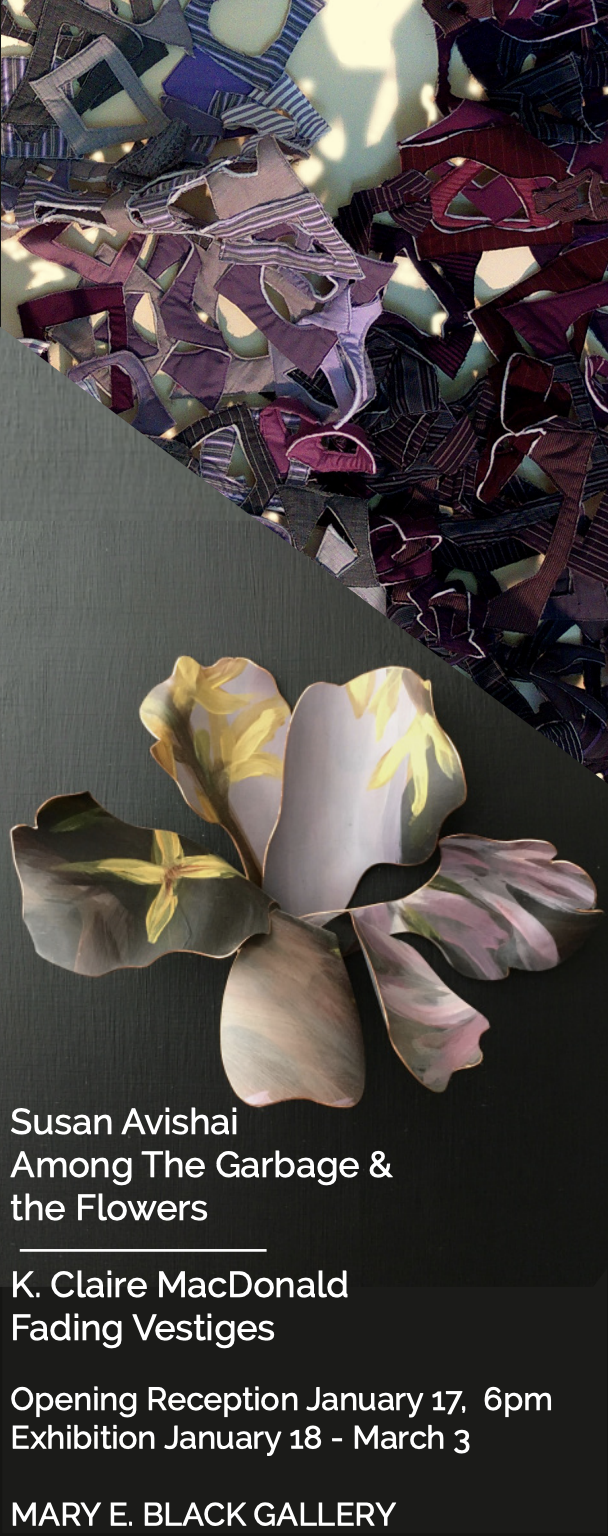Exhibition Statement
The Mary E. Black Gallery presents artists K. Claire MacDonald and Susan Avishai in side by side solo shows that explore memory, loss and transformation through the deconstruction/reconstruction of surface design.
Susan Avishai’s body of textile works in Among the Garbage & the Flowersbegan with the deconstruction of her mothers clothing. Tenderly saving the patterned material by piecing the textiles back together to form soft sculptures; a tangible transformation of memory. Among the Garbage & the Flowers provokes a dialog about material use, to reuse before discarding and to think more consciously about the longevity of what we purchase or make to clothe ourselves.
In Fading Vestiges K. Claire MacDonald applies a painted surface to metal then cuts and shapes it into delicate flowers. Gentle brush strokes and hues touch the surface of her jewelry merging these mediums of formal art and craft. Uncovering a flower press from childhood K. Claire MacDonald opened a small time capsule of perfectly preserved mementos sparking an exploration of Fading Vestiges. The artist draws on various flora as metaphors for memories of people and places.
Both Avishai and MacDonald cross disciplines and explore the deconstruction of surface patterns. Each artist mirrors the other in their use of colors creating a harmonious dialog of personal memory and material exploration in the Mary E. Black Gallery.
“I seek to embrace the intended state of uncertainty. It is in this ambiguity that traces of different disciplines can cross, tangle and dissolve, and move into a new context with greater clarity.” ~ K. Claire MacDonald
Artist Statements
Among the Garbage & the Flowers
Susan Avishai
“I began making fibre art from ‘pre-owned’ clothing after my mother died and I was unable to part with her garments for the life, memories, and familiar scents still present in the fabric. Eventually I boldly cut up some of her things, creating a tangible transformation: memory into art. So too did the clothes I began bringing home from thrift shops, have their embedded stories. These I knew nothing about. But the labels, Made in Bangladesh…Cambodia…Sri Lanka, told me some of the history. Our clothing was being manufactured in what had become a lightning quick cycle of underpaid workers living in miserable conditions, given inexpensive fabric and knock-off design, all in order to keep us Westerners supplied with cheap garments. They are worn briefly and discarded quickly. 85% of it ends up in landfill. That’s over 10 million tons of textile waste a year in Canada alone. And although nearly all of it is recyclable, only a minute part gets baled up for resale in the Third World, or made into rags, shredded for upholstery fill and insulation.
Textile waste is one of our most pressing problems, as landfill gradually takes over scarcer space, uses up resources, and adds toxicity to our natural environment. We must do better. But from this problem can come amazingly creative solutions, including artistic expression, as my diverted stream of shirts (infinitesimal as it is) tries to prove.
Inspired by the materials themselves, and incorporating everything I’ve learned to date about making art, I am choosing cast-off clothing as my medium for surprisingly novel, edgy, and whimsical art. And with it brings social commentary about ourselves, our relationship to our clothing, about climate change, impermanence, and reclamation. Upcycling stretches our imaginations when we play in the sand, experimenting with new uses and art forms, and seeing that life still resides in what we toss unthinkingly into those big metal bins. I hope that viewers will leave a little provoked, a little delighted, and asking themselves, what else can we do with what we no longer want? And maybe I’ve even shown you where to look, among the garbage and the flowers.”
Fading Vestiges
K. Claire MacDonald
“This body of sculptural works embodies my continued exploration of paint on metal, and investigates how certain traditional methods of both painting and metalsmithing are altered and/or appropriated in effort to merge the two disciplines. My process begins by applying paint directly on a flat sheet of copper. When the painting is complete, the imagery is deconstructed and obscured using traditional metalsmithing techniques to manipulate the copper sheet into three-dimensional forms.
Several of the pieces in this exhibition are directly inspired by the uncovering of my childhood flower press from nearly twenty year ago. Inside the press I found pages of paper-thin flowers that were perfectly preserved, almost as if frozen in time. I became consumed by the way in which the contents of the flower press had remained relatively unchanged over twenty years while the world outside of it continued to change and transform. The notion of pressed flowers as mementos -markers of time and place- became deeply fascinating to me. In this body of work I draw upon various flora as metaphors to hold close people, places, and feelings from the past while exploring subjects of fading memory, loss, and transformation.
The presented ambiguity between jewellery and object, function and decoration is amplified by the fragmented painted imagery that quietly masks the metal surface of each form. Although the mind may wish to untangle the pieces and restore order, I seek to embrace the intended state of uncertainty. It is in this ambiguity that traces of different disciplines can cross, tangle and dissolve, and move into a new context with greater clarity.“

